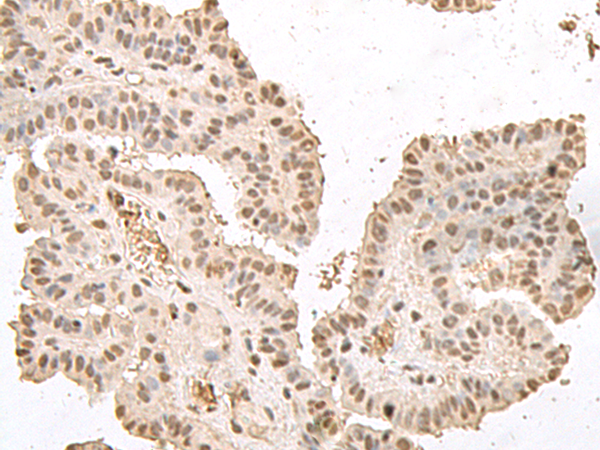
| WB | 咨询技术 | Human,Mouse,Rat |
| IF | 咨询技术 | Human,Mouse,Rat |
| IHC | 1/30-1/150 | Human,Mouse,Rat |
| ICC | 技术咨询 | Human,Mouse,Rat |
| FCM | 咨询技术 | Human,Mouse,Rat |
| Elisa | 1/5000-1/10000 | Human,Mouse,Rat |
| Aliases | HMG17 |
| Host/Isotype | Rabbit IgG |
| Antibody Type | Primary antibody |
| Storage | Store at 4°C short term. Aliquot and store at -20°C long term. Avoid freeze/thaw cycles. |
| Species Reactivity | Human, Mouse, Rat |
| Immunogen | Fusion protein of human HMGN2 |
| Formulation | Purified antibody in PBS with 0.05% sodium azide and 50% glycerol. |
+ +
以下是关于HMGN2抗体的3篇参考文献及其摘要内容:
---
1. **文献名称**: *HMGN2 regulates autophagy as a potential therapeutic target in hepatocellular carcinoma*
**作者**: Li Y, et al.
**摘要**: 该研究通过Western blot和免疫组化分析,利用HMGN2抗体检测肝癌组织中蛋白表达水平,发现HMGN2通过调控自噬相关通路抑制肿瘤生长,提示其作为肝癌治疗靶点的潜力。
---
2. **文献名称**: *Antimicrobial activity of HMGN2: A chromatin-associated protein with dual functions*
**作者**: Wang X, et al.
**摘要**: 研究使用HMGN2抗体进行免疫荧光定位,证实HMGN2不仅参与染色质结构调控,还作为抗菌肽直接杀伤革兰氏阴性菌,揭示了其在先天免疫中的双重功能。
---
3. **文献名称**: *HMGN2 interacts with histone H3 to modulate chromatin accessibility*
**作者**: Kim T, et al.
**摘要**: 通过ChIP-seq和免疫沉淀实验(使用HMGN2特异性抗体),研究发现HMGN2与组蛋白H3相互作用,促进染色质松弛并增强转录因子结合能力,为基因表达调控提供机制解释。
---
以上文献均涉及HMGN2抗体的实验应用(如蛋白检测、定位或互作研究),并聚焦于HMGN2在疾病、免疫及表观遗传中的功能。
HMGN2 (High Mobility Group Nucleosome-Binding Domain 2) is a member of the high-mobility group (HMG) protein family, characterized by its ability to bind chromatin and regulate DNA accessibility. As a non-histone chromatin-associated protein, HMGN2 modulates nucleosome structure and interacts with transcription factors to influence gene expression, DNA repair, and epigenetic regulation. It is ubiquitously expressed in mammalian tissues and plays a role in cellular processes such as differentiation, proliferation, and stress responses.
Antibodies targeting HMGN2 are essential tools for studying its function and localization. These antibodies are typically developed using immunogenic peptides or recombinant HMGN2 protein, enabling specific detection in techniques like Western blotting, immunofluorescence, and chromatin immunoprecipitation (ChIP). Researchers utilize HMGN2 antibodies to investigate its involvement in diseases, including cancer (where it may act as an oncogene or tumor suppressor depending on context), inflammatory disorders, and neurodegenerative conditions.
Studies have also explored HMGN2's role in maintaining stem cell pluripotency and its dynamic behavior during the cell cycle. Validation of HMGN2 antibodies includes verifying cross-reactivity across species and confirming absence of cross-reactivity with other HMGN family members (e.g., HMGN1. HMGN3). Reliable HMGN2 antibodies are critical for elucidating its chromatin-remodeling mechanisms and therapeutic potential in disease models.
×